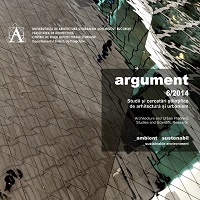CLĂDIREA DE CĂLĂTORI: GENERATOR DURABIL ŞI AUTONOM DE AMBIENT ÎN ACTUALUL CONTEXT AL ARHITECTURII FEROVIARE DIN ROMÂNIA
THE RAILWAY STATION BUILDING: SUSTAINABLE AND AUTONOMOUS AMBIENT GENERATOR IN THE CURRENT CONTEXT OF THE RAILWAYS ARCHITECTURE IN ROMANIA
Author(s): George StăncioiuSubject(s): Architecture, Transport / Logistics
Published by: Editura Universitară “Ion Mincu”
Keywords: railway station building; environmental protection; renewable sources; sustainability; energy conservation; integrated ambient;
Summary/Abstract: If the multifunctional space associated to the architecture of the railway buildings for travelers define the “railway station phenomenon” in all the aspects of historical, typological and functional evolution, the reconceiving of the railway station gives a new meaning to the railway station buildings. The main directions in the current design, at the beginning of this new century, are meant at the ecology and environmental protection, besides the support of the “green house” idea, already developing concepts like the construction passivity, energies from alternate and renewable sources, sustainable and durable architecture, based on the energy conservation, as an up-date, or a well deserved refresh. It is vital to design an integrated ambient which takes into account the users’ senses, in order to stimulate the capacity of inducing positive emotions, sensations and states of spirit. This approach is aimed at outlining a new type of architecture, of activated action, intensified by technology, as well as by an individual way of knowledge economy, pertaining both to the ambient and to the users’ interests. The proposed study is also representing a personal contribution, promoted as a reaction to the conjectural tendencies marking and conditioning the evolution of the buildings for travelers on the railways, by: I. Solutions to ameliorate the structural - aesthetic and functional image of the traditional, transit railway stations in Romania; II. Reconsideration of the platforms issue, as an interface between the railway and the travelers building (i.e. industrial- civil, railway-public); III. Assimilation of the “Eurostation” concept: prognosis and effects of the program application in the Romanian railway stations (the up-date limitations); IV. Increasing the space potential, by using the not yet exploited areas and surfaces or the residual ones in the buildings for travelers. Bestowing the up to date requirements, as far as possible, without compromising the aesthetical and stylistic values, is achieved not only by removing the non-values and logically segregating the space to cross (i.e. stream) and repose (i.e. the waiting one), but also searching for technical solutions in such a given space and by assuming the new directions in a perimeter imposed by “another order”, that is new needs outlining the “next step” concept. The idea of “plurivalent architecture”, by compacting and diversification, exceeding the unidirectional character in the concept of the conventional public space is also consolidated and applied in time by the redesign as a possible redelimitation of the spheres that define the railway station idea today: i.e. an industrial-technological space (to be integrated and exploited) and public space ( to recycle and render good value to). In Romania, following the “historical layers “ juxtaposition, the ways and possibilities of applying the new directions, together with the forecasting of the expected effects, are presented as moments outside the evolutional memory space. Without the risk of a forced segregation in the collective mentality, or of the erroneous understanding and generalization of the Eurostation concept, initiated by the European Community, there is a tendency towards the reset area and reinterpretation of the space destined to the travelers, function of the possibilities and of the obvious potential of the existing buildings, by ample selective redesign programmes. The generation of today’s requirements, as well as the long term projections, endorse the individual expectancy and needs. All this “attitude” redefines the railway station of the future, from a simple space destined strictly to waiting for the train, to a complex, sustainable and renewable phenomenon, and the process does not stop here!
Journal: Argument
- Issue Year: 2014
- Issue No: 6
- Page Range: 207-221
- Page Count: 15
- Language: English, Romanian

